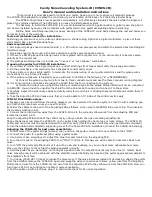
ADT7476
Rev. B | Page 15 of 72
R/W
0
SCL
SDA
1
0
1
1
A1
A0
D7
D6
D5
D4
D3
D2
D1
D0
ACK. BY
ADT7476
STOP BY
MASTER
START BY
MASTER
FRAME 1
SERIAL BUS ADDRESS BYTE
FRAME 2
ADDRESS POINTER REGISTER BYTE
1
1
9
ACK. BY
ADT7476
9
05382-020
Figure 19. Writing to the Address Pointer Register Only
R/W
0
SCL
SDA
1
0
1
1
A1
A0
D7
D6
D5
D4
D3
D2
D1
D0
NO ACK. BY
MASTER
STOP BY
MASTER
START BY
MASTER
FRAME 1
SERIAL BUS ADDRESS BYTE
FRAME 2
DATA BYTE FROM ADT7476
1
1
9
ACK. BY
ADT7476
9
05382-021
Figure 20. Reading Data from a Previously Selected Register
It is possible to read a data byte from a data register without
first writing to the address pointer register if the address pointer
register is already at the correct value. However, it is not possible
to write data to a register without writing to the address pointer
register because the first data byte of a write is always written to
the address pointer register.
In addition to supporting the send byte and receive byte
protocols, the ADT7476 also supports the read byte protocol.
(See
System Management Bus (SMBus) Specifications Version 2
for more information; it is available
)
If several read operations or write operations must be performed
in succession, the master can send a repeat start condition
instead of a stop condition to begin a new operation.
WRITE OPERATIONS
The SMBus specification defines several protocols for different
types of read and write operations. The ones used in the ADT7476
are discussed in this section and the next section. The following
abbreviations are used in the diagrams:
S – Start
P – Stop
R – Read
W – Write
A – Acknowledge
A – No acknowledge
The ADT7476 uses the following SMBus write protocols.
Send Byte
In this operation, the master device sends a single command
byte to a slave device, as follows:
1.
The master device asserts a start condition on SDA.
2.
The master sends the 7-bit slave address followed by
the write bit (active low).
3.
The addressed slave device asserts ACK on SDA.
4.
The master sends a command code.
5.
The slave asserts ACK on SDA.
6.
The master asserts a stop condition on SDA, and the
transaction ends.
For the ADT7476, the send byte protocol is used to write a
register address to RAM for a subsequent single-byte read from
the same address. This operation is illustrated in Figure 21.
05382-022
SLAVE
ADDRESS
W A
S
A P
REGISTER
ADDRESS
2
3
1
5
6
4
Figure 21. Setting a Register Address for Subsequent Read
If the master is required to read data from the register immedi-
ately after setting up the address, it can assert a repeat start
condition immediately after the final ACK and carry out a
single-byte read without asserting an intermediate stop
condition.
www.BDTIC.com/ADI
















































